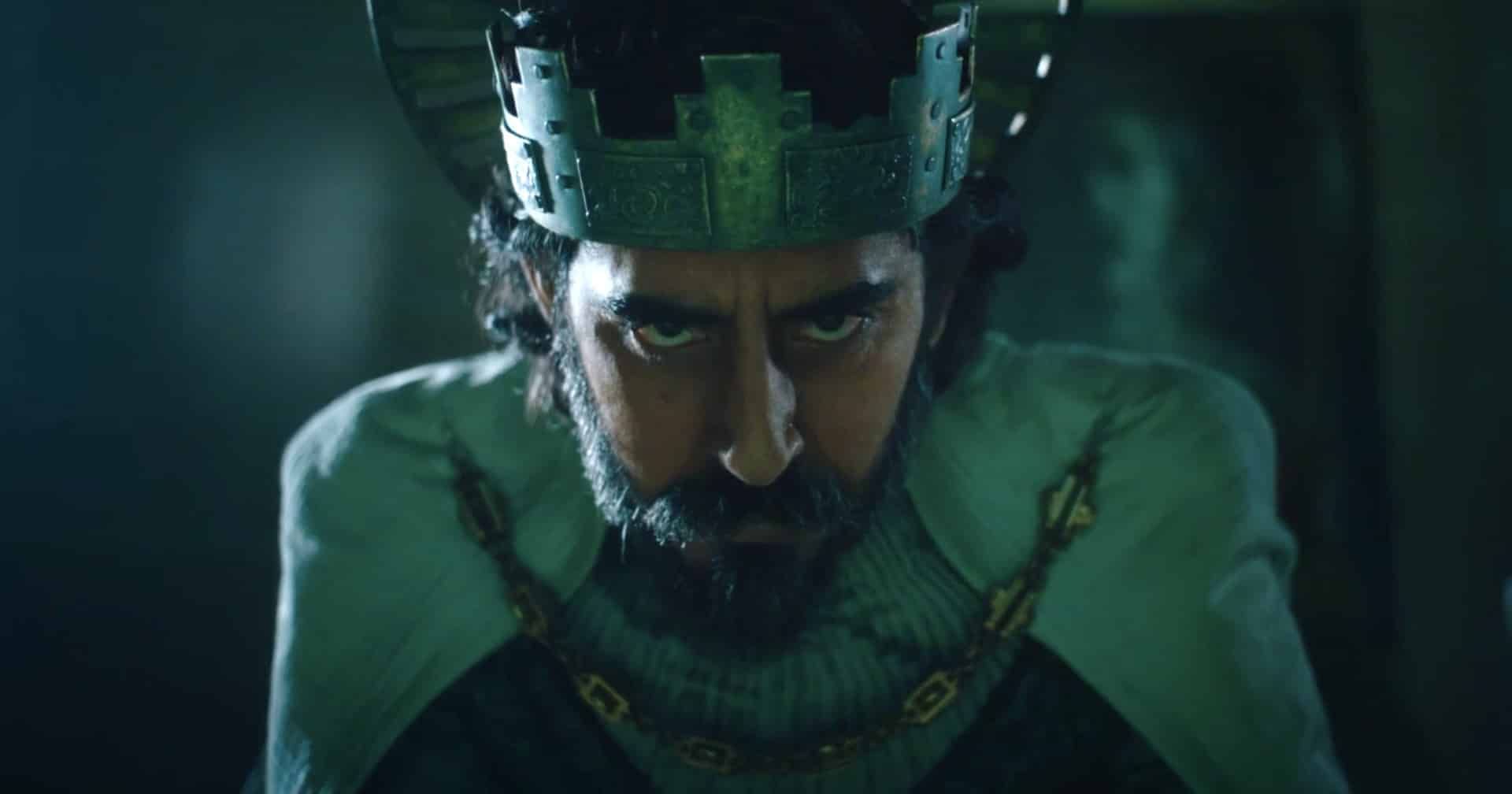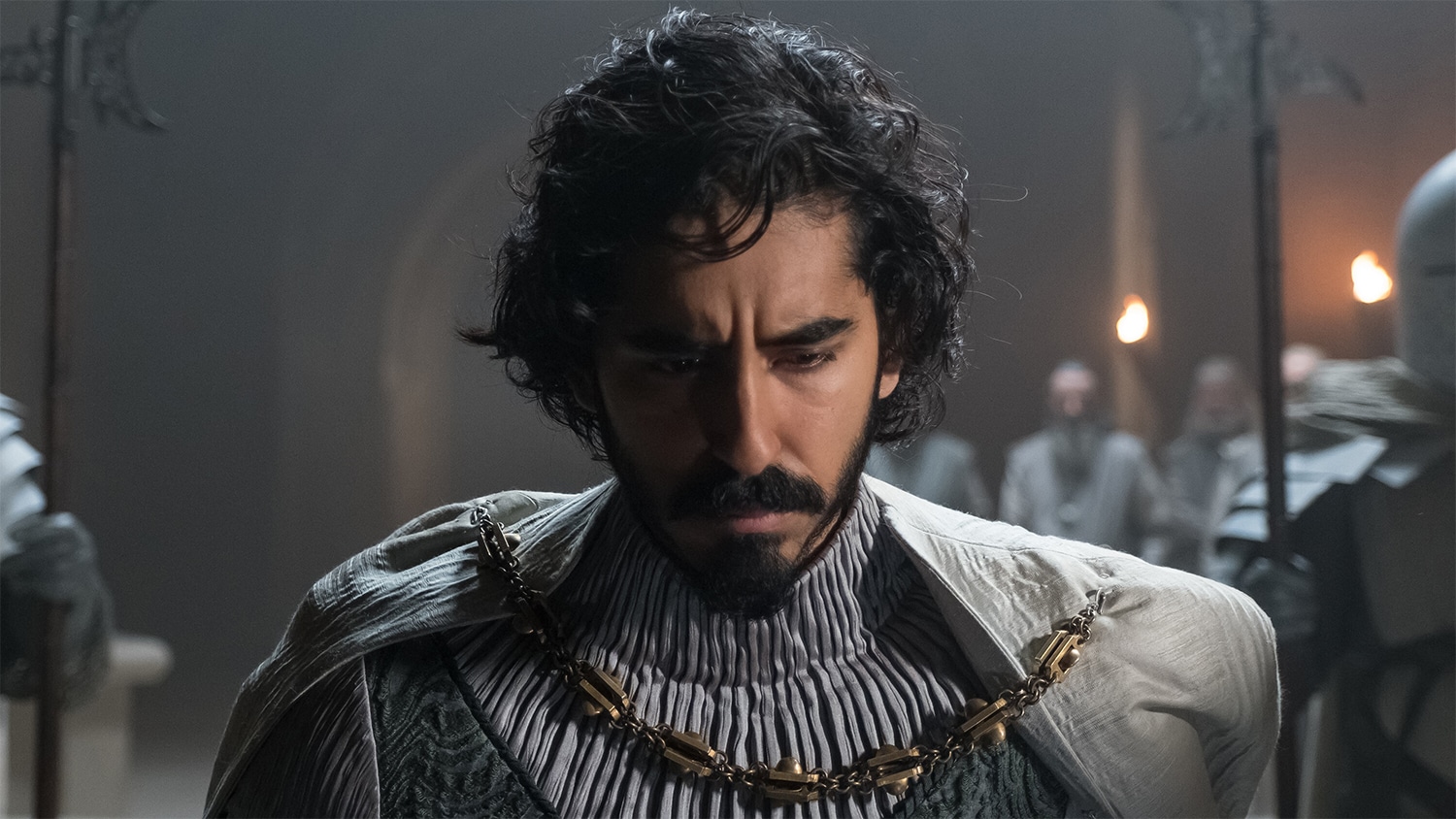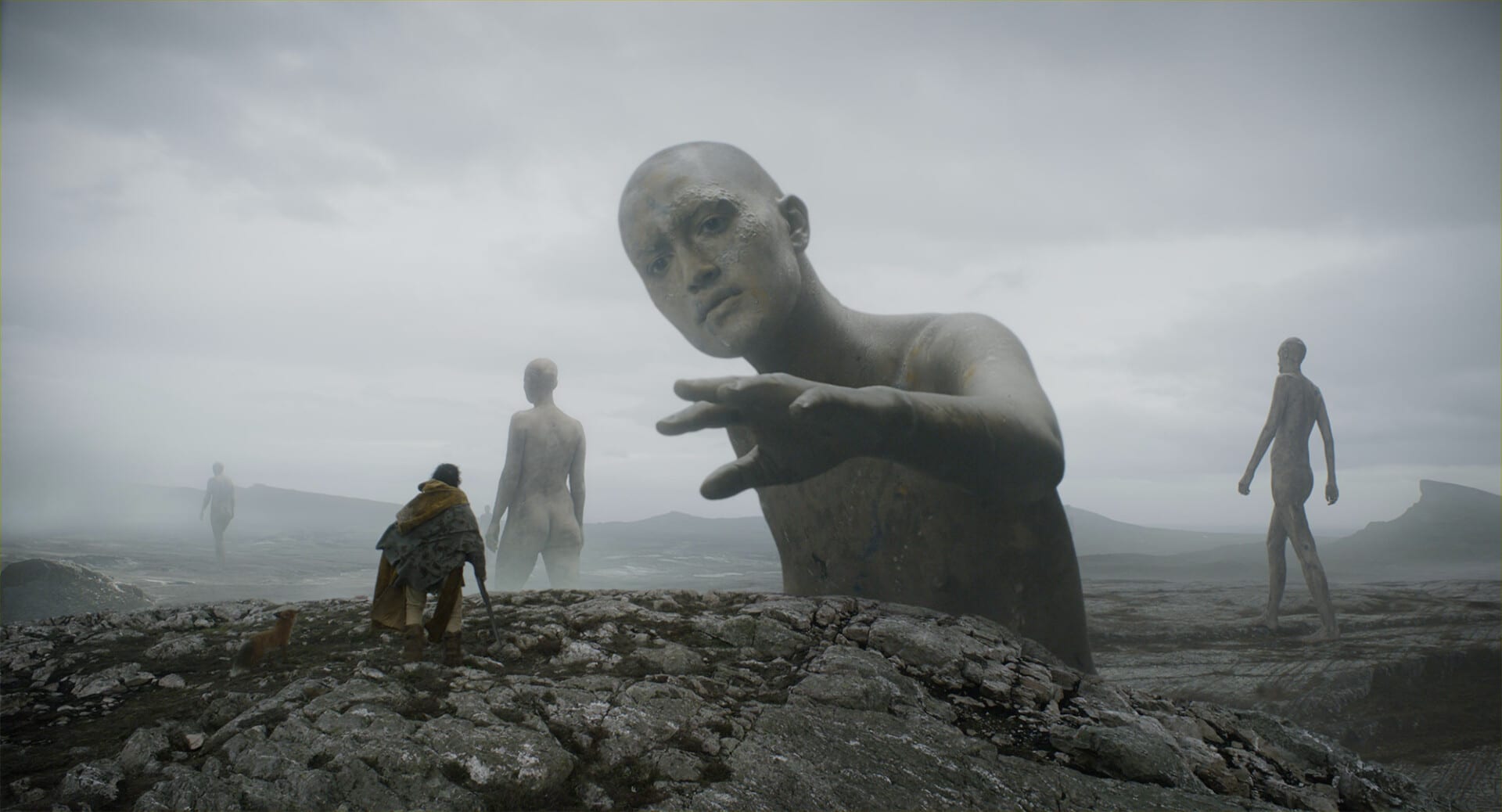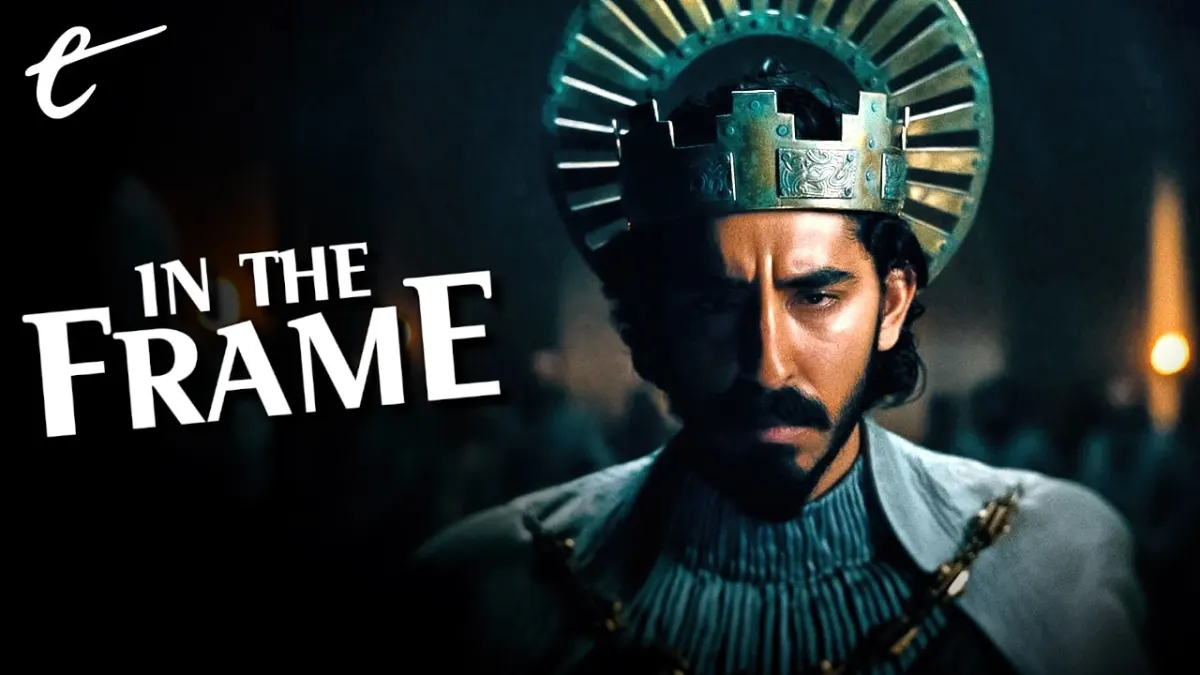This article contains extensive spoilers for The Green Knight.
The Green Knight is a story about stories.
The entire premise of the movie is built around the idea of myth-making and storytelling. The film’s inciting incident occurs as the knights of the realm assemble to celebrate Christmas. The King (Sean Harris) addresses the court, asking any of his subjects for “a tale or a show” to mark the occasion. “Who can regale me and my queen with some myth or canto of thine own purport?” he inquires. As if on cue, a mysterious stranger (Ralph Ineson) arrives to start the movie’s story in earnest.
The hero’s journey is one of the most archetypal story templates in existence, famously codified by Joseph Campbell with the publication of The Hero with a Thousand Faces in 1949. The basic idea is that the hero ventures out into the world on some mythic and transformative quest, an adventure that fundamentally changes both the hero themselves and their understanding of the world. The template has been applied to countless stories, from Star Wars to The Matrix.
One of the most enduring examples of the hero’s journey remains J.R.R. Tolkien’s The Lord of the Rings, which Tolkien finished the first draft of in the same year that The Hero with a Thousand Faces was published. Tolkien’s saga follows a Hobbit named Frodo, who embarks on a perilous journey to save Middle-earth. Towards the end, Frodo muses on how the adventure has changed him, “There is no real going back. Though I may come to the Shire, it will not seem the same; for I shall not be the same.”
The Green Knight is built around this idea of a mythic journey that might transform its hero. Over Christmas dinner, the King sits with his young nephew Gawain (Dev Patel). “You tell me a tale of yourself, so that I might know thee,” the King requests, admitting regret that he does not really know his young relative. “I have none to tell, King,” Gawain admits. There is a pause. “Yet,” the Queen (Kate Dickinson) firmly corrects. “You have none to tell yet.”

Gawain is a young man waiting for greatness to happen to him. “I’m not ready yet,” he admits early on. “I’m not ready.” When asked whether he is a knight, he replies, “Not yet.” Told to “hurry up,” he insists, “I’ve got time. I’ve got lots of time.” When the mysterious stranger interrupts the Yuletide festivities, Gawain sees an opportunity to carve a place for himself. He boldly accepts the visitor’s proposal of “a friendly Christmas game.”
The rules of the game are simple. Gawain will get a first strike at the figure. However, he also promises to make his own journey to the Green Chapel one year later to receive his own blow in kind. Gawain beheads his opponent, believing that will resolve the situation. However, the decapitated creature picks up its head and rides away, reminding Gawain of his promise. The bulk of the movie follows Gawain on his journey “six nights to the North” to face his opponent once again.
David Lowery’s The Green Knight is a loose adaptation of the chivalric romance Sir Gawain and the Green Knight. It is an Arthurian saga. In fact, many of the unnamed figures in The Green Knight are meant to be figures from Arthurian legend. The King is Arthur. The Queen is Guinevere. The King’s sword is Excalibur. Tolkien worked on one of the most famous translations of the story, and his son Christopher noted that he devoted “much thought and study” to it.
It makes sense that Tolkien would be drawn to the story. After all, much has been made of Tolkien’s efforts to codify “a mythology for England,” although Tolkien himself never used those actual words. For Tolkien, Lord of the Rings was an attempt “to modernize the myths and make them credible” to a new generation. Historians have described Tolkien’s grand saga as “a work of historical reconstruction,” to create a unified set of legends for England.

As such, it is interesting to compare and contrast Tolkien’s work with Arthurian legend. There is no singular Arthurian canon. The myths and legends are often contradictory, with key characters like Morgan le Fay reimagined and repurposed between retellings. There have been attempts to distill Arthurian legends to single linear epics — like T.H. White’s The Once and Future King or John Boorman’s Excalibur — but the stories are messy and diverse, capable of evolving and changing.
The Green Knight understands this. The film’s opening narration alludes to the classic Arthurian legend of “the boy who pulled sword from stone,” only to warn viewers that “this is not that king and nor is this his song,” but is “instead a new tale.” Late in the story, Gawain takes shelter with a Lord (Joel Edgerton) and Lady (Alicia Vikander) and is impressed by their library. The Lady explains, “Some I’ve written, some I’ve copied. They’re tales I’ve heard, songs that have been sung to me.”
However, the Lady doesn’t just preserve these stories, confessing, “I write them down and sometimes — don’t tell anyone this — sometimes, when I see room for improvements, I make them.” She offers to gift Gawain a portrait of himself. “I’ve had my portrait made already,” he tells her. “Not by me,” she responds. She proceeds to render a primitive photograph of the young adventurer. It is an inverted image.
Sir Gawain and the Green Knight has an ending typical of a story like this. The whole story is revealed to have been a test. Gawain cheats by wearing an enchanted sash that grants him invulnerability, but then he feels ashamed that he acted deceitfully. The Green Knight absolves him. Gawain returns home and confesses his sins. In response, all the court “comfort the knight.” They then wear green sashes to remind them to always be honest. Gawain learns something. He grows. He changes.

The Green Knight is constructed in mockery of that classic heroic epic, of the tales of heroes who venture forth in search of greater purpose and who return home better for that. The Lord asks why Gawain is embarking on this quest. “Honor,” Gawain replies. “That is why a knight does what he does.” The Lord wonders, “And this is all it takes for that part to be had? You’ll do this one thing, you return home a changed man, an honorable man? Just like that?” Gawain answers, “Yes.”
The characters in The Green Knight believe in the transformative power of the journey itself. When the King insists that Gawain make the journey, Gawain asks, “Why are you holding me to this light?” The King responds, “Is it wrong to want greatness for you?” Gawain confesses, “I fear I am not meant for greatness.” Gawain tells his lover Essel (Vikander) that these adventures are “how brave men become great.” Essel responds, “Why greatness? Why is goodness not enough?”
The journey cannot fundamentally change who Gawain is. When he is finally confronted by his mysterious opponent, he flinches. When chided that he had a full year to find the courage to face the blow, Gawain replies, “One year or a hundred, it wouldn’t make a difference.” Throughout the film, there are hints that Gawain is not a man of honor. It is simply not in his character to behave in an honorable fashion, even if he goes through the motions of a heroic journey.
He initially refuses to compensate a scavenger (Barry Keoghan) for help on his quest but immediately asks what St. Winifred (Erin Kellyman) will do in return for his own aid. “Why would you ask me that?” Winifred responds. “Why would you ever ask me that?” Later, he sees giants traversing the landscape, and his first thought is to hitchhike by requesting a ride on their shoulders. He also wears the green sash from the original story, removing any stakes.

Even with the sash’s protection, Gawain cannot accept the blow that is due to him. He panics and retreats, failing his hero’s journey. The Green Knight plays out an extended hallucinatory sequence that recalls The Last Temptation of Christ, where Gawain sees his future: He sees his betrayal of his lover Essel for a more politically opportune match, the death of his son, the fall of his kingdom. He has not returned home changed; he has just returned home. He is still the same. He is not great.
It is clear that he must complete his journey. He must accept the blow. He must show that he can change. The Green Knight ends with the monster drawing its finger across Gawain’s throat and promising, “Now, off with your head.” Although it is somewhat ambiguous, Lowery has stated that Gawain still dies at the end of his journey. Lowery explains, “I wanted to write an ending where his head gets chopped off, and that’s a positive thing.”
To a certain extent, this is the happiest possible ending to the story. Gawain embraces chivalric virtue. He becomes brave. He earns his own story and myth. “Now I’m ready,” he confesses calmly in his final line. “I’m ready now.” However, this seems to be the only possible outcome of Gawain’s journey: Either he returns home unchanged or he is changed and never returns. It is not the story he was promised. “Is this really all there is?” he asks. His opponent replies, “What else ought there be?”
There is perhaps a cruel irony to The Green Knight, a sense that Gawain was doomed from the outset. “Be it a scratch on the cheek or a cut on the throat, I will return what was given to me, and then in trust and friendship we shall part,” his opponent promised in that opening challenge. “You understand this challenge?” the King asks. “I do,” Gawain replies. He hesitates. “I think I do.” The King’s last advice to Gawain is to “remember it is only a game.”
The implication is clear. Gawain could have chosen to give the visitor “a scratch on the cheek” and then received the same wound in kind the following year. Instead, he chose a killing stroke. Although The Green Knight is an ambiguous film, the reaction shots from the King and Queen suggest that Gawain has sealed his own fate by decapitating his opponent — and that the other characters are familiar enough with the tropes of these sorts of stories to understand that.
The Green Knight suggests that not all are meant to venture out into the world and return home great. Sometimes the choice is to return home unchanged or not to return home at all.





